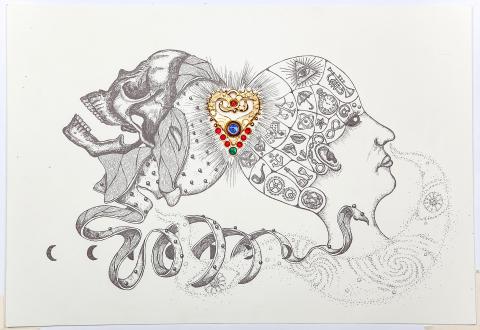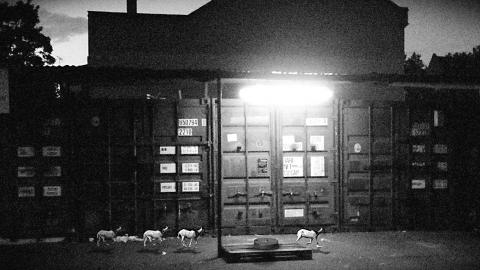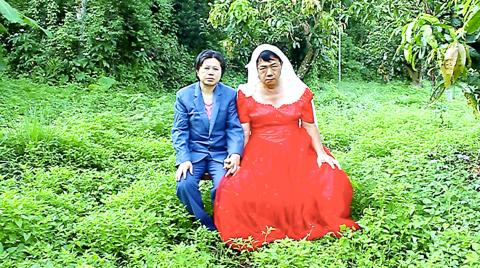Frees Art Space, a little basement gallery in Taipei’s Zhongzheng District (中正區), is known for being a tad kooky — their last two exhibitions were about aliens and the Wizard of Oz. Their latest exhibition, Coexist + Exhibition Death at Daybreak? (多元成展見光死?) is even more out there. Bringing together works of artists from all over Taiwan, the central themes are gay rights and gender equality. Rather than a sugar-coated, lovey-dovey narrative, the approach is rather NSFW — as in pictures of nude males with female private parts. Yet the images, which are beautiful as much as they are provocative, serve as a poignant remember that regardless of how far we have come, we still have a long way to go in terms of achieving gay rights and gender equality.
■ Frees Art Space (福利社), B1, 82, Xinsheng N Rd Sec 3, Taipei City (台北市新生北路三段82號B1); tel: (02) 2585-7600. Open Tuesdays to Fridays from 11am to 7pm, Saturdays 1:30pm to 9pm, closed Sundays and Mondays
■ Until May 2

Photo courtesy of Eslite Gallery
Chen Ching-yao’s (陳擎耀) paintings appear to tread a fine line between tolerable cosplay and weird, fetish porno — perky girls in too-tight uniforms tease and tantalize deified dictators and despots. Chen says his artwork is influenced by the history of militarism and obedience in Taiwan, Japan and South Korea. That may explain why school girls are holding guns in some of his paintings, but why do their underwear also have to be showing? Upon closer examination, though, it becomes obvious that Chen is doing this as playful satire — it’s also hinted in the exhibition’s title Dear Mr Chen, We Love You! (親愛的Mr Chen,我們愛您!). The exhibition is currently on display at VT Art Salon, another gallery known for curating bizarre exhibitions.
■ VT Art Salon (非常廟藝文空間), B1, 47 Yitong St, Taipei City (台北市伊通街47號B1), tel: (02) 2516-1060. Open Tuesdays through Thursdays from 1:30pm to 9pm, and Fridays and Saturdays from 1:30pm to 10pm
■ Until May 2

Photo courtesy of Project Fulfill Art Space
Avid costume jewelry collector Ho Pong-pong (何思芃) not only knows how to accessorize, but she is also extremely skilled at creating thought-provoking artwork inspired by her brooches and other bling. Her latest solo exhibition, Think of Pong, at Taipei’s Eslite Gallery, includes a selection of jewelry from her branded collection — including Boucher, Coro, Monet — displayed alongside her own sketches. Pong’s drawings, which tend to the more surreal and absurd, express her darkest ruminations on the human body, relationships and personal development. Yet cracked skulls never looked so beautiful when laced with the sparkly studs from pendants.
■ Eslite Gallery (誠品畫廊), 5F, 11 Songgao Rd, Taipei City (台北市松高路11號5樓), tel: (02) 8789-3388. Open Tuesdays to Sundays from 11am to 7pm
■ Until May 3

Photo courtesy of Frees Art Space
The magic mirror in Snow White and the Seven Dwarfs may have held all-encompassing truths for the evil queen, but for Japanese video installation artist Hiraki Sawa, mirrors are mysterious things which may or may not reflect reality. In Envelope, Sawa installed three large mirrors in different sides of a room such that they reflect a projected image. Viewers can only understand the image in its entirety after observing all three mirrors. The idea is to pull viewers into a virtual realm, forcing them to rethink the framework of human existence. This piece and other video installations are currently on display in the exhibition Terrain at Project Fulfill Art Space.
■ Project Fulfill Art Space (就在藝術空間), 2, Alley 45, Ln 147, Xinyi Rd Sec 3, Taipei City (台北市信義路三段147巷45弄2號), tel: (02) 2707-6942. Open Tuesdays to Sundays from 1pm to 6pm
■ Until May 16
Cherry blossom trees are known for their cheery pink hue, signaling the start of spring after a long drawn-out winter. Yet Japanese artist Sugiura Masakazu does the unthinkable by photographing them in black and white. By doing so, Masakazu reminds viewers that beauty is fleeting, and that life is a cycle which ultimately involves death. Masakazu took the photos when there were few crowds around, mostly on rainy days and at sunrise. His photographs are currently on display at his solo show Oukakou (櫻花行) at the 1839 Contemporary Gallery.
■ 1839 Contemporary Gallery (當代藝廊), B1, 120 Yanji St, Taipei City (台北市延吉街120號B1), tel: (02) 2778-8458. Open Tuesdays to Sundays from 11am to 8pm
■ Until May 17
Birds and flowers are not just pretty to look at; they are also imbued with plenty of positive meaning — prosperity, longevity, dignity — in Chinese art. The National Palace Museum currently has an exhibition entitled Flights of Fragrance at a Fingertip: The World of Birds and Flowers in Painting, Tapestry and Embroidery (十指春風-緙繡與繪畫的花鳥世界). As you might have guessed, birds and flowers feature largely. Although these were already prominent motifs in artwork dating back to the Shang Dynasty over 3,000 years ago, it didn’t see its heyday until the Song Dynasty. During this period, from 960-1279AD, birds and flowers made the transition from paintings to needlework in tapestries. From then on, the bird-and-flower motif could be found everywhere from lacquered silk paintings to the insides of rare books, its purpose being to add aesthetic value, making a piece of art appear highly valuable.
■ National Palace Museum (國立故宮博物院), 221 Zhishan Rd Sec 2, Taipei City (台北市至善路二段221號), tel: (02) 2881-2021. Open daily from 9am to 5pm
■ Until June 25

June 9 to June 15 A photo of two men riding trendy high-wheel Penny-Farthing bicycles past a Qing Dynasty gate aptly captures the essence of Taipei in 1897 — a newly colonized city on the cusp of great change. The Japanese began making significant modifications to the cityscape in 1899, tearing down Qing-era structures, widening boulevards and installing Western-style infrastructure and buildings. The photographer, Minosuke Imamura, only spent a year in Taiwan as a cartographer for the governor-general’s office, but he left behind a treasure trove of 130 images showing life at the onset of Japanese rule, spanning July 1897 to

In an interview posted online by United Daily News (UDN) on May 26, current Chinese Nationalist Party (KMT) Chairman Eric Chu (朱立倫) was asked about Taichung Mayor Lu Shiow-yen (盧秀燕) replacing him as party chair. Though not yet officially running, by the customs of Taiwan politics, Lu has been signalling she is both running for party chair and to be the party’s 2028 presidential candidate. She told an international media outlet that she was considering a run. She also gave a speech in Keelung on national priorities and foreign affairs. For details, see the May 23 edition of this column,

The Taiwan People’s Party (TPP) on May 18 held a rally in Taichung to mark the anniversary of President William Lai’s (賴清德) inauguration on May 20. The title of the rally could be loosely translated to “May 18 recall fraudulent goods” (518退貨ㄌㄨㄚˋ!). Unlike in English, where the terms are the same, “recall” (退貨) in this context refers to product recalls due to damaged, defective or fraudulent merchandise, not the political recalls (罷免) currently dominating the headlines. I attended the rally to determine if the impression was correct that the TPP under party Chairman Huang Kuo-Chang (黃國昌) had little of a

At Computex 2025, Nvidia CEO Jensen Huang (黃仁勳) urged the government to subsidize AI. “All schools in Taiwan must integrate AI into their curricula,” he declared. A few months earlier, he said, “If I were a student today, I’d immediately start using tools like ChatGPT, Gemini Pro and Grok to learn, write and accelerate my thinking.” Huang sees the AI-bullet train leaving the station. And as one of its drivers, he’s worried about youth not getting on board — bad for their careers, and bad for his workforce. As a semiconductor supply-chain powerhouse and AI hub wannabe, Taiwan is seeing